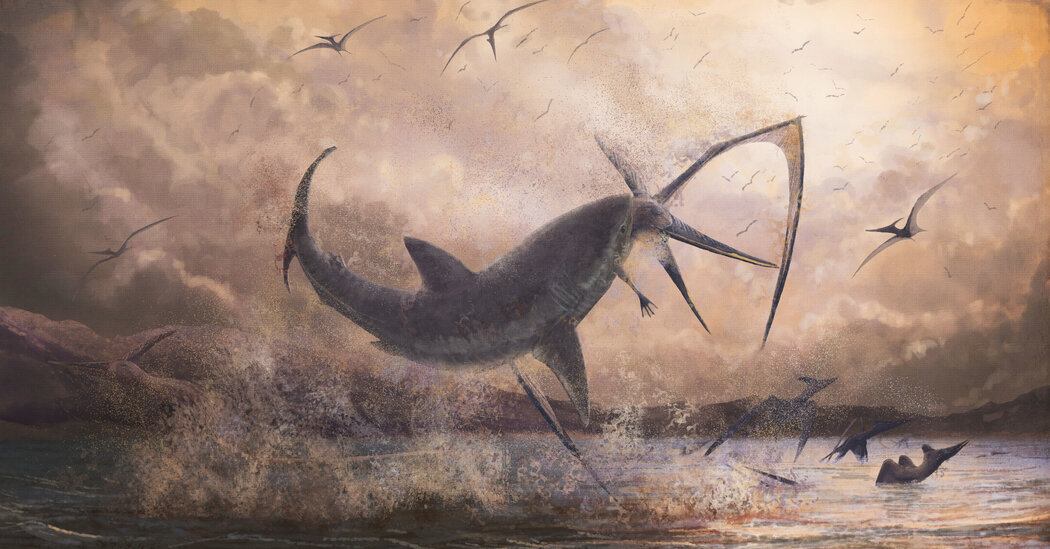It sounds like something out of a Hollywood film script, but it really happened: Shark-evolution researchers say that increased ocean temperatures more than 100 million years ago may have caused sharks to grow bigger, swim faster and become the powerful predators we know today.
In a paper published last month in the journal Current Biology, scientists reported that they measured fin sizes and body lengths of 500 extinct and living sharks and compared that information with data from the evolutionary shark family tree. Their results indicate that when the ocean got very hot approximately 122 million years ago during the Cretaceous period, some sharks abandoned their habitat on the seafloor and moved up into the open ocean. That ascent may have altered their fin and body structure, which led to changes in their size and ability to swim.
It is a misconception that all sharks are like the bloodthirsty, powerful and streamlined beasts of “Jaws” that swim close to the ocean surface (or in tornadoes and city streets, if you’ve watched “Sharknado”). Most sharks have always been benthic, meaning they’re bottom feeders. Unlike their pelagic — or open water — relatives, benthic sharks don’t need to constantly swim in order to breathe. They can rest on the seafloor.
The need to breathe, however, might have been just the prompt that moved some sharks higher into the water column. Cretaceous ocean bottoms, the authors posit, may have become increasingly oxygen-poor in places. For the ancestors of many modern sharks to survive and eventually thrive, it was time to ditch the sea bottom.
Clues to this habitat shift, and what endured in which environment, are seen in the changing pectoral fins of ancient pelagic and benthic sharks.
“Most of the open-water sharks tend to have elongated fins, and the benthic sharks have stubbier fins,” said Lars Schmitz, a biology professor at Claremont McKenna College in California who is an author of the paper.
His fellow author Phillip Sternes, a shark researcher based in California, compared pectoral fins to wings on a plane. “Long narrow wings” — like those of a commercial plane, for example — “help your lift-to-drag ratio, so it lowers your cost of fuel,” he said. In contrast, the “short, stubby wings of fighter aircraft are not good for long-distance travel, but they can turn on a dime.”
The same holds true for sharks: Longer pectoral fins may have made swimming more efficient for larger-bodied sharks, an important adaptation for species whose breathing now required constant swimming.
But it’s not just body and fin size that may have increased. The peak of Cretaceous ocean surface temperature at about 83 degrees Fahrenheit might have affected shark speed. (For comparison, today’s average is 68 degrees.)
Sharks and other fish are similar to most animals, Timothy Higham, a co-author and professor at the University of California, Riverside, explained, “in that the muscle function is very temperature-dependent.” In other words, he said, “if your muscles warm up, they become better at contracting quickly.”
Warmer temperatures and faster, quicker muscles meant sharks “could beat their tail back and forth faster,” he said. This translates to increased speed, which, he added, might have then led sharks to “expand into a more open water habitat,” catching fast-swimming prey and avoiding other Cretaceous marine predators that are now extinct.
Which all sounds advantageous. With ocean temperatures increasing now because of global warming, could we see similar changes in today’s sharks? In other words, could sharks get even bigger and faster?
Global warming millions of years ago may have introduced important evolutionary adaptations in some sharks, but Dr. Higham emphasized that today’s rapidly changing climate is more likely to result in damage to life in the ocean.
“Because other animals, nonshark organisms, were absolutely devastated,” he said. He added that while some sharks adapted to the Cretaceous oceans, “it also caused a lot of other animals to go extinct.”
Allison Bronson, a faculty member at California State Polytechnic University, Humboldt, who was not involved in the research, agreed.
“The spread of marine anoxic zones and changes in global climate, often co-occurring with ocean acidification, have resulted in the worst mass extinctions in Earth’s history,” she said, adding that “the pace of change now is really unprecedented.”





